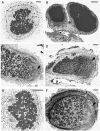Legume evolution: where do nodules and mycorrhizas fit in?
- PMID: 17556520
- PMCID: PMC1914177
- DOI: 10.1104/pp.107.096156
Legume evolution: where do nodules and mycorrhizas fit in?
Figures


References
-
- Alexander IJ (1989) Systematics and ecology of ectomycorrhizal legumes. In CH Stirton, JL Zarucchi, eds, Advances in Legume Biology. Monographs in Systematic Botany, Vol 29. Missouri Botanical Garden, St. Louis, pp 617–624
-
- Allen ON, Allen EK (1981) The Leguminosae: A Source Book of Characteristics, Uses and Nodulation. University of Wisconsin Press, Madison, WI/Macmillan Publishing, London
-
- Batut J, Andersson GE, O'Callaghan DO (2004) The evolution of chronic infection strategies in the α-proteobacteria. Nat Rev Microbiol 2 933–945 - PubMed
-
- Blauenfeldt J, Pa J, Gresshoff PM, Caetano-Anolles G (1994) Nodulation of white clover (Trifolium repens) in the absence of Rhizobium. Protoplasma 179 106–110
Publication types
MeSH terms
LinkOut - more resources
Full Text Sources
Other Literature Sources

